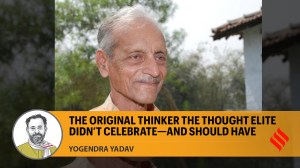The list of centrally protected monuments in India should be rationalised on the basis of their national significance, while the Archaeological Survey of India (ASI) should be divided into two wings to make the organisation more effective, a parliamentary committee has noted.
The ‘Three Hundred Fifty Ninth Report on Functioning of Archaeological Survey of India’ by the department-related Parliamentary Standing Committee on Transport, Tourism and Culture was presented to the Rajya Sabha and laid on the table of the Lok Sabha on Thursday.

The parliamentary panel chaired by YSR Congress’s V Vijaisai Reddy has observed that the list of ASI-protected sites includes a large number of “minor monuments” and recommended that they should be “rationalised and categorised” on the basis of their national significance and unique architectural and heritage value.
Highlighting “problems” with the list of centrally protected monuments, the report said there were a large number of minor monuments with no national significance. “It is estimated that this applies to at least a quarter of the current list of 3,691 monuments. The list, for instance, includes 75 graves of colonial-era soldiers or officials of no notable importance,” it observed.
For example, a small brick wall enclosure containing two colonial-era graves of public works department engineer John Albert Cope (died in 1880) and Henry Gassen (died 1877), an employee of a cotton ginning company, in Kumta, Karnataka is a centrally-protected monument, the report pointed out.
“The structure had no architectural value, and the individuals were of no historical significance. Yet, they are supposed to get the same level of protection as the country’s most cherished monuments,” it said.
This is in consonance with the view of the government, which proposes to reintroduce the Ancient Monuments and Archaeological Sites and Remains (AMASR) (Amendment) Bill in the coming session, with “an aim to redefine monuments and rationalise the use of the area around the protected monuments”, as reported by The Indian Express earlier.
Story continues below this ad
Union Culture Minister G Kishan Reddy had said the discussions on the draft AMASR (Amendment) Bill are in the final stage and the legislation will be tabled in Parliament soon. Currently, a monument has to be at least 100 years old. But sources say there is a view to change that benchmark and go back since India has a wealth of ancient monuments, while most 100-year-old monuments pertain to the time of the Britishers.
This would be in line with the government wanting to shed “its colonial past”, as announced by the Prime Minister at various fora to mark Amrit Kaal or 75 years of Independence.
The AMASR Act also prohibits construction up to 100 metres around protected monuments, except under certain conditions. An area up to a 200-metre radius beyond the prohibited area is demarcated as a regulated area. No construction work or related activity is generally permitted in these prohibited and regulated areas in case of all protected monuments across the country, unless specific approval is taken from the National Monuments Authority (NMA).
There is a feeling that this restricts a lot of areas which could be put to good use, specifically in cases of developmental and infrastructure-related work. It is expected that the amendments will pertain to making some relaxation in these zones, specifically in case of smaller and less significant monuments such as statues, cemeteries, cannons etc., which do not need such a big area around them to be restricted for their protection.
Story continues below this ad
However, in the case of UNESCO World Heritage Sites (India has 42 of them now), these restrictions may stay. The report said that the restrictions around protected monuments need to be “rationalised” as per the significance of the site.
The panel has also noted that, till date, 531 monuments or 14.4 per cent of the ASI’s total 3,691 centrally-protected monuments have been encroached. However, encroachments from only nine monuments have been removed since 2015, the report said, adding that there is a lack of clarity in the guidelines for preservation and a delay in the classification of centrally protected monuments.
“The committee recommends that the ASI should conduct a comprehensive survey of encroachments around all monuments under its jurisdiction and document the nature, extent and impact of encroachments on each site to create a database for informed decision-making in this regard,” the report said.
The panel advised that the ASI be divided into two wings – the Archaeological Survey of India (ASI) and the India Heritage Development Corporation (IHDC) – to make it an effective organisation.
Story continues below this ad
While the former can look after the core mandate of the ASI, i.e. exploration, excavation and conservation aspects, the latter can deal with the ASI’s entire revenue, such as ticket collection, conducting auctions, issuing licences, running cafeterias, selling mementoes, running sound and light systems etc., it added.
The committee recommended that the “list of monuments with ASI should be rationalised and categorised on the basis of their national significance, unique architectural value and specific heritage content,” the parliamentary panel report on the functioning of ASI said.
The Ministry of Culture has informed the committee that the government is “working to bring an Amendment’ to the rules to make it “relevant and contemporaneous”, the report says.









